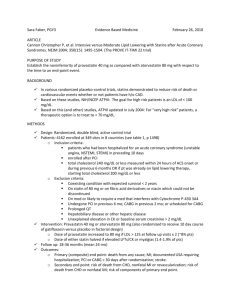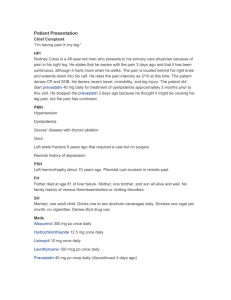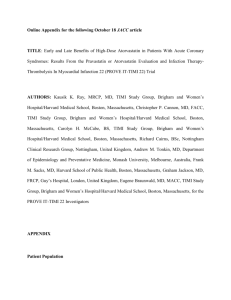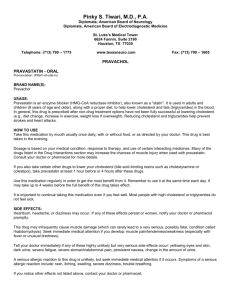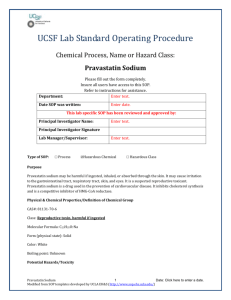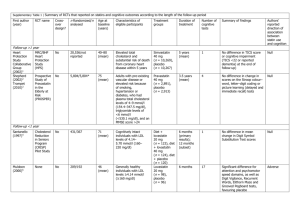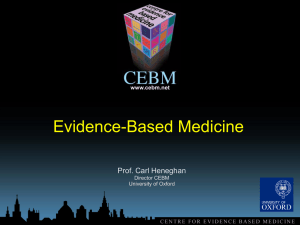Cholvastin, Tablet
advertisement
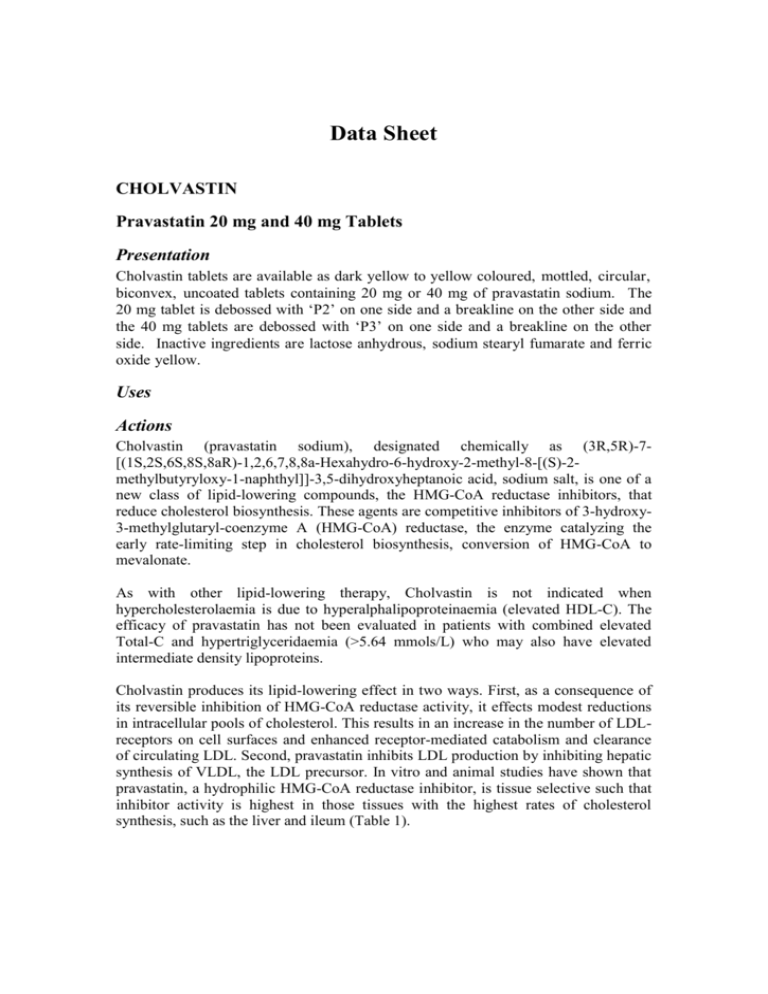
Data Sheet CHOLVASTIN Pravastatin 20 mg and 40 mg Tablets Presentation Cholvastin tablets are available as dark yellow to yellow coloured, mottled, circular, biconvex, uncoated tablets containing 20 mg or 40 mg of pravastatin sodium. The 20 mg tablet is debossed with ‘P2’ on one side and a breakline on the other side and the 40 mg tablets are debossed with ‘P3’ on one side and a breakline on the other side. Inactive ingredients are lactose anhydrous, sodium stearyl fumarate and ferric oxide yellow. Uses Actions Cholvastin (pravastatin sodium), designated chemically as (3R,5R)-7[(1S,2S,6S,8S,8aR)-1,2,6,7,8,8a-Hexahydro-6-hydroxy-2-methyl-8-[(S)-2methylbutyryloxy-1-naphthyl]]-3,5-dihydroxyheptanoic acid, sodium salt, is one of a new class of lipid-lowering compounds, the HMG-CoA reductase inhibitors, that reduce cholesterol biosynthesis. These agents are competitive inhibitors of 3-hydroxy3-methylglutaryl-coenzyme A (HMG-CoA) reductase, the enzyme catalyzing the early rate-limiting step in cholesterol biosynthesis, conversion of HMG-CoA to mevalonate. As with other lipid-lowering therapy, Cholvastin is not indicated when hypercholesterolaemia is due to hyperalphalipoproteinaemia (elevated HDL-C). The efficacy of pravastatin has not been evaluated in patients with combined elevated Total-C and hypertriglyceridaemia (>5.64 mmols/L) who may also have elevated intermediate density lipoproteins. Cholvastin produces its lipid-lowering effect in two ways. First, as a consequence of its reversible inhibition of HMG-CoA reductase activity, it effects modest reductions in intracellular pools of cholesterol. This results in an increase in the number of LDLreceptors on cell surfaces and enhanced receptor-mediated catabolism and clearance of circulating LDL. Second, pravastatin inhibits LDL production by inhibiting hepatic synthesis of VLDL, the LDL precursor. In vitro and animal studies have shown that pravastatin, a hydrophilic HMG-CoA reductase inhibitor, is tissue selective such that inhibitor activity is highest in those tissues with the highest rates of cholesterol synthesis, such as the liver and ileum (Table 1). Table 1 Inhibition Of Cholesterol Synthesis In Rat Tissue Slices By PRAVASTATIN Tissue % Inhibition Liver 93.1 Ileum 94.8 Kidney 29.8 Lung 2.5 Spleen 0.0 Cerebrum 0.0 Prostate 10.4 Testis 7.6 Adrenal 7.8 Muscle 0.0 Skin 0.0 Clinical and pathologic studies have shown that elevated levels of total cholesterol (Total-C), low density lipoprotein cholesterol (LDL-C) and apolipoprotein B (a membrane transport complex for LDL) promote human atherosclerosis. Similarly, decreased levels of HDL-cholesterol (HDL-C) and its transport complex, apolipoprotein A, are associated with the development of atherosclerosis. Epidemiologic investigations have established that cardiovascular morbidity and mortality vary directly with the level of Total-C and LDL-C and inversely with the level of HDL-C. In multicentre clinical trials those pharmacologic and/or nonpharmacologic interventions that lowered Total-C and LDL-C and increased HDL-C reduced the rate of cardiovascular events (both fatal and nonfatal myocardial infarctions) and improved survival. In both normal volunteers and patients with hypercholesterolaemia, treatment with pravastatin sodium tablets reduced Total-C, LDL-C , apolipoprotein B , VLDL-C and TG while increasing HDL-C and apolipoprotein A. Pravastatin sodium tablets are highly effective in reducing Total-C and LDL-C in patients with heterozygous familial, familial combined, and nonfamilial (non-FH) forms of hypercholesterolaemia. A therapeutic response is seen within 1 week, and the maximum response usually is achieved within 4 weeks. This response is maintained during extended periods of therapy. A single daily dose administered in the evening is as effective as the same total daily dose given twice a day. Once daily administration in the evening appears to be marginally more effective than once daily administration in the morning, perhaps because hepatic cholesterol is synthesized mainly at night. In multicentre, double-blind, placebo-controlled studies of patients with primary hypercholesterolaemia, treatment with pravastatin significantly decreased Total-C, LDL-C, and Total-C/HDL-C and LDL-C/HDL-C ratios, decreased VLDL-C and plasma TG levels, and increased HDL-C. Whether administered once or twice daily, a clear dose-response relationship (i.e. lipid-lowering) was seen by 1 to 2 weeks following the initiation of treatment. Primary Hypercholesterolaemia Study Dose response of pravastatin sodium tablets* Once Daily Administration At Bedtime Dose Total C LDL-C HDL-C TG 5mg -14% -19% + 5% -14% 10mg -16% -22% + 7% -15% 20mg -24% -32% + 2% -11% 40mg -25% -34% +12% -24% * Percent change from baseline after 8 weeks Pravastatin monotherapy was effective in reducing both the progression of atherosclerosis and cardiovascular event rates in two controlled trials among patients with moderate hypercholesterolaemia and atherosclerotic cardiovascular disease. The Pravastatin Limitation of Atherosclerosis in the Coronary Arteries trial (PLAC I) was a 3 year, randomised, double-blind, placebo-controlled, multicenter trial among 408 patients with moderate hypercholesterolaemia (baseline mean LDL-C=163 mg/dL, Total-C=231 mg/dL) and coronary artery disease; 206 of these patients received pravastatin. In a prospectively planned analysis of clinical events occurring 90 days after initiating therapy to allow for maximum lipid lowering effect, treatment with pravastatin resulted in a 74% reduction in the rate of myocardial infarction (fatal and nonfatal) [p=0.006], and a 62% reduction for the combined endpoint of nonfatal myocardial infarction or all cause death [p=0.02]. For the entire study duration, myocardial infarction (fatal and non-fatal) rate was reduced by 60% [p=0.0498]. The Pravastatin Limitation of Atherosclerosis in the Carotid Arteries trial (PLAC II) was a 3-year, randomised, double-blind, placebo-controlled trial among 151 patients with moderate hypercholesterolaemia (baseline mean LDL-C=164 mg/dL, TotalC=234 mg/dL), and coronary and carotid atherosclerosis. A reduction of 80% in the rate of myocardial infarction (fatal and nonfatal) [p=0.018], and a 61% reduction for the combined endpoint of nonfatal myocardial infarction or all cause death [p=0.049] were observed among 75 patients treated with pravastatin. In an analysis of pooled clinical cardiovascular events from the PLAC I and PLAC II trials, treatment with pravastatin was associated with a 63% reduction in the event rates for myocardial infarction (fatal and nonfatal) [p=0.003], and a 52% reduction for the combined endpoint of nonfatal myocardial infarction or all cause death [p=0.009]. In hypercholesterolemic patients without clinically evident coronary heart disease, Cholvastin is indicated as an adjunct to diet to reduce the risk of fatal and non-fatal myocardial infarction, need for myocardial revascularisation procedures, and to improve survival by reducing cardiovascular deaths. Pravastatin sodium tablets are effective in reducing the risk of coronary heart disease (CHD) death (fatal MI and sudden death) plus non-fatal MI and improving survival in hypercholesterolemic patients without previous myocardial infarction. The West of Scotland Study (WOS) was a randomised, double-blind, placebocontrolled trial among 6595 male patients (44-66 years) with moderate to severe hypercholesterolemia (LDL-C=156-254mg/dL [4-6.6mmol/L]), and without a previous MI. Patients were treated with standard care, including dietary advice, and either pravastatin (N=3302) or placebo (N=3293) for a median duration of 4.8 years. The study was designed to assess the effect of pravastatin on fatal and non-fatal coronary heart disease (CHD). Pravastatin significantly reduced the risk of CHD death plus non-fatal MI by 31% (p=0.0001). The effect on these cumulative cardiovascular event rates was evident as early as 6 months of treatment. This reduction was similar and significant throughout the entire range of LDL cholesterol levels and age groups studied. A significant reduction of 32% (p=0.03) in total cardiovascular deaths was observed. When adjusted for baseline risk factors, a 24% (p=0.039) reduction in overall mortality was also observed among patients treated with pravastatin. There was no statistically significant difference between treatment groups in non-cardiovascular mortality, including cancer death. Pravastatin also decreased the risk for undergoing myocardial revascularisation procedures (coronary artery bypass graft surgery or coronary angioplasty) by 37% (p=0.009) and coronary angiography by 31% (p=0.007). In patients with a history of either myocardial infarction or unstable angina pectoris pravastatin sodium tablets are effective in reducing the risk for total mortality, CHD death, recurrent coronary events (including myocardial infarction), frequency of stroke or transient ischemic attacks, need for myocardial revascularisation procedures, and need for hospitalisation. In the Long-Term Intervention with Pravastatin in Ischemic Disease (LIPID) study, the effect of pravastatin was assessed in 9014 men and women with normal to elevated serum cholesterol levels (baseline Total-C=4.0-7.0 mmol/L); mean TotalC=5.66 mmol/L), and who had experienced either a myocardial infarction or had been hospitalised for unstable angina pectoris in the preceding 3-36 months. Patients with a wide range of baseline levels of triglycerides were included (#5.0 mmol/L) and enrollment was not restricted by baseline levels of HDL cholesterol. At baseline, 82% of patients were receiving aspirin and 76% were receiving antihypertensive medication. Patients in this multicentre, double-blind, placebo-controlled study participated for a mean of 5.6 years (median=5.9years). Treatment with pravastatin significantly reduced the risk for CHD death by 24% (p=0.0004). The risk for coronary events (either CHD death or nonfatal MI) was significantly reduced by 24% (p<0.0001) in the pravastatin treated patients. The risk for fatal or nonfatal myocardial infarction was reduced by 29% (p<0.0001). Pravastatin reduced both the risk for total mortality by 23% (p<0.0001) and cardiovascular mortality by 25% (p<0.0001). The risk for undergoing myocardial revascularisation procedures (coronary artery bypass grafting or percutaneous transluminal coronary angioplasty) was significantly reduced by 20% (p<0.0001) in the pravastatin treated patients. Pravastatin also significantly reduced the risk for stroke by 19% (p=0.0477). Treatment with pravastatin significantly reduced the number of days of hospitalisation per 100 person-years of follow-up by 15% (p<0.001). The effect of pravastatin on reducing CHD events was consistent regardless of age, gender, or diabetic status. Among patients who qualified with a history of myocardial infarction, pravastatin significantly reduced the risk for total mortality and for fatal or non-fatal MI (risk reduction for total mortality=21%,p=0.0016; risk reduction for fatal or non-fatal MI=25%,p=0.0008). Among patients who qualified with a history of hospitalisation for unstable angina pectoris, pravastatin significantly reduced the risk for total mortality and for fatal or non-fatal MI (risk reduction for total mortality=26%,p=0.0035; risk reduction for fatal or non-fatal MI=37%, p=0.0003). In the Cholesterol and Recurrent Events (CARE) study the effect of pravastatin on coronary heart disease death and nonfatal MI was assessed in 4159 men and women with average (normal serum cholesterol levels (baseline mean Total-C=209mg/dL), and who had experienced a mycocardial infarction in the preceding 3-20 months. Patients in this double-blind, placebo-controlled study participated for an average of 4.9 years. Treatment with pravastatin significantly reduced the rate of a recurrent coronary event (either CHD death or nonfatal MI) by 24% (p=0.003). The reduction in risk for this combined endpoint was significant for both men and women. The risk of undergoing revascularization procedures (coronary artery bypass grafting or percutaneous transluminal coronary angioplasty) was significantly reduced by 27% (p<0.001) in the pravastatin treated patients. Pravastatin also significantly reduced the risk for stroke by 32% (p=0.032), and stroke or transient ischemic attack (TIA) combined by 26% (p=0.025). The safety and efficacy of pravastatin treatment in patients receiving immunosuppressive therapy following cardiac and kidney transplantation were assessed in two prospective randomised controlled studies. Patients were treated concurrently with either proavastatin (20-40mg) or no pravastatin, and a standard immunosuppressive regimen cyclosporin and prednisone. Cardiac transplant patients also received azathioprine as part of the immunosuppresive regimen. Treatment with pravastatin significantly reduced the rate of cardiac rejection with haemodynamic compromise at one year (p=0.005), improved one-year survival (p=0.025), and lowered the risk of coronary vasculopathy in the transplant as determined by angiography and autopsy (p=0.049). In patients following kidney transplantation, pravastatin significantly reduced the incidence of biopsy-proven acute rejection episodes (p=0.01), the incidence of multiple rejections episodes (p<0.05), and the use of pulse injections of both methylprednisolone (p=0.01) and OKT3 (p=0.02). Plasma lipid levels were favorably altered by pravastatin treatment. Pravastatin was well tolereated with no significant increases in creatine phosphokinase or hepatic transaminases. In addition, there were no reported cases of myositis or rhabdomyolysis. Pharmacokinetics Cholvastin is administered orally in the active form. It is rapidly absorbed, with peak plasma levels attained 1 to 1.5 hours following ingestion. Based on urinary recovery of radiolabelled drug, the average oral absorption of pravastatin is 34% and absolute bioavailability is 17%. While the presence of food in the gastrointestinal tract reduces systemic bioavailability, the lipid-lowering effects of the drug are similar whether taken with or without food. Pravastatin undergoes extensive first-pass extraction in the liver (extraction ratio 0.66), which is its primary site of action, and the primary site of cholesterol synthesis and of LDL-C clearance. Since it is excreted in the bile, plasma levels are of limited value in predicting lipid-lowering efficacy. Pravastatin plasma concentrations [including: area under the concentration-time curve (AUC), peak (Cmax), and steadystate minimum (Cmin)] are directly proportional to administered dose. Pravastatin sodium tablets administered once-daily at bedtime was more effective than after a morning dose despite a lower systemic bioavailability. Steady-state AUCs, Cmax and Cmin plasma concentrations showed no evidence of pravastatin accumulation following once or twice daily administration of pravastatin sodium tablets. Approximately 50% of the circulating drug is bound to plasma proteins. The plasma elimination half-life (T1/2) of pravastatin (oral) is between 1.5 and 2 hours. Approximately 20% of a radiolabelled oral dose is excreted in urine and 70% in the faeces. After intravenous administration of radiolabelled pravastatin to normal volunteers, approximately 47% of total body clearance was via renal excretion and 53% by nonrenal routes (i.e. biliary excretion and biotransformation). Accumulation of pravastatin and/or metabolites may occur in patients with renal or hepatic insufficiency, although, since there are dual routes of elimination, the potential exists for compensatory excretion by the alternate route. The major degradation product of pravastatin is the 3a-hydroxy isomeric metabolite. This metabolite has one-tenth to one-fortieth the HMG-CoA reductase inhibitory activity of the parent compound. Indications 1. In hypercholesterolemic patients without clinically evident coronary heart disease, Cholvastin is indicated as an adjunct to diet to reduce the risk of fatal and non-fatal myocardial infarction, need for myocardial revascularisation procedures, and to improve survival by reducing cardiovascular deaths. 2. Cholvastin is indicated for the reduction of elevated total and LDL-cholesterol levels in patients with primary hypercholesterolaemia when the response to diet and other nonpharmacological measures alone have been inadequate. 3. Cholvastin is indicated as an adjunct to diet to slow the progressive course of atherosclerosis and reduce the incidence of clinical cardiovascular events in hypercholesterolaemic men under 75 years of age with coronary artery disease. 4. Coronary Artery Disease: In patients with a history of either a myocardial infarction or unstable angina pectoris, Cholvastin is indicated to reduce the risk for total mortality, CHD death, recurrent coronary event (including myocardial infarction), need for myocardial revascularisation procedures, and need for hospitalisation. 5. Cerebrovascular Disease: In patients with a history of coronary artery disease (i.e. either a myocardial infarction or unstable angina pectoris), Cholvastin is indicated to reduce the risk of stroke or transient ischemic attacks (TIAs). 6. Cardiac and Renal Transplantation: In patients receiving immunosuppressive therapy, Cholvastin is indicated to improve survival in cardiac transplant patients and to reduce the risk of acute rejection in kidney transplant patients. Dosage and Administration Prior to initiating Cholvastin, the patient should be placed on a standard cholesterollowering diet which should be continued during treatment. Prior to initiating therapy with Cholvastin, secondary causes for hypercholesterolaemia (e.g. obesity, poorly controlled diabetes mellitus, hypothyroidism, nephrotic syndrome, dysproteinaemias, obstructive liver disease, other medicine therapy, alcoholism) should be excluded, and a lipid profile performed to measure Total-C, HDL-C, and TG. For patients with triglycerides (TG) less than 4.52 mmols/L, LDL-C can be estimated using the following equation: LDL-C = Total-C - HDL-C - 1/5 TG. For TG levels > 4.52 mmols/L, this equation is less accurate and LDL-C concentrations should be determined by ultracentrifugation. Since the goal of treatment is to lower LDL-C, the National (United States) Cholesterol Education Programme recommends that LDL-C levels be used to initiate and assess treatment response. Only if LDL-C levels are not available should the Total-C be used to monitor therapy. Adult Patients The recommended starting dose is 10 to 20mg once daily at bedtime. If serum cholesterol is markedly elevated (e.g. Total-C greater than 7.76 mmols/L), dosage may be initiated at 40mg per day. Cholvastin may be taken without regard to meals. Since the maximal effect of a given dose is seen within four weeks, periodic lipid determinations should be performed at this time and dosage adjusted according to the patient's response to therapy and established treatment guidelines. The recommended dosage range is 10 to 40mg administered once a day at bedtime. Cholvastin may be given in divided doses. For the prevention of coronary heart disease in hypercholesterolemic patients the dose is 40mg per day as a single dose. For cardiac and renal transplantation patients the recommended dose is 10-20mg as a single dose. Paediatric Patients Children (Ages 8 to 13 Years, Inclusive) The recommended dose is 20 mg once daily in children 8-13 years of age. Doses greater than 20mg have not been studied in this patient population. Adolescents (Ages 14 to 18 Years) The recommended dose is 40 mg once daily in adolescents 14 to 18 years of age. Doses greater than 40 mg have not been studied in this patient population. Children and adolescents treated with pravastatin should be re-evaluated in adulthood and appropriate changes made to their cholesterol-lowering regimen to achieve adult goals for LDL-C. Concomitant Therapy Some patients may require combination therapy with one or more lipid-lowering agents. Pharmacokinetic interaction studies with pravastatin administered concurrently with nicotinic acid, probucol, and gemfibrozil (see PRECAUTIONS, Skeletal Muscle) did not demonstrate any alterations in the bioavailability of pravastatin. The lipid-lowering effects of Cholvastin on Total and LDL cholesterol are enhanced when combined with a bile acid-binding resin. When administering pravastatin and a bile acid-binding resin (e.g. cholestyramine, colestipol), pravastatin should be given either one hour or more before or at least four hours following the resin. In patients taking cyclosporin, with or without other immunosuppressive drugs, concomitantly with pravastatin, therapy should be initiated with 10mg per day and titration to higher doses should be performed with caution. The maximum pravastatin dose for patients treated with this combination should not exceed 20mg/day. Contraindications Hypersensitivity to any component of this medication. Active liver disease or unexplained persistent elevations in liver function tests. Pregnancy and lactation. Atherosclerosis is a chronic process and discontinuation of lipid-lowering drugs during pregnancy should have little impact on the outcome of long-term therapy of primary hypercholesterolaemia. Cholesterol and other products of cholesterol biosynthesis are essential components for foetal development (including synthesis of steroidsand cell membranes). Since HMG-CoA reductase inhibitors decrease cholesterol synthesis and possibly the synthesis of other biologically active substances derived from cholesterol, they may cause foetal harm when administered to a pregnant woman. Therefore, HMG-CoA reductase inhibitors are contraindicated during pregnancy. Women of childbearing potential. Cholvastin should be administered to women of childbearing age only when such patients are highly unlikely to conceive and have been informed of the potential hazards. If the patient becomes pregnant while taking this class of medicine, therapy should be discontinued and the patient again advised of the potential hazard to the foetus. Warnings and Precautions General HMG-CoA reductase inhibitors have been associated with biochemical abnormalities of liver function. As with other lipid-lowering agents, including nonabsorbable bile acid-binding resins, increases in liver enzymes to less than three times the upper limit of normal have occurred during therapy with pravastatin. The significance of these changes, which usually appear during the first few months of treatment initiation, is not known. In the majority of patients treated with pravastatin in clinical trials, these increased values declined to pretreatment levels despite continuation of therapy at the same dose. Marked persistent increases (greater than three times the upper limit of normal) in serum transaminases were seen in 6 out of 1139 (0.5%) patients treated with pravastatin in clinical trials. These elevations were not associated with clinical signs and symptoms of liver disease and usually declined to pretreatment levels upon discontinuation of therapy. Only two patients had marked persistent abnormalities possibly attributable to therapy. As with other lipid-lowering agents, liver function tests should be performed before treatment begins and periodically thereafter in all patients. Special attention should be given to patients who develop increased transaminase levels. Liver function tests should be repeated to confirm any elevation and subsequently monitored at more frequent intervals. If increases in alanine aminotransferase (ALT) and aspartate aminotransferase (AST) equal or exceed three times the upper limit of normal and persist, therapy should be discontinued. Caution should be exercised when Cholvastin is administered to patients with a history of liver disease or heavy alcohol ingestion. Skeletal Muscle Myalgia, myopathy, and rhabdomyolysis have been reported with the use of HMGCoA reductase inhibitors. Uncomplicated myalgia has rarely been reported in pravastatin-treated patients. Myopathy, defined as muscle aching or muscle weakness in conjunction with increases in CK values to greater than 10 times the upper limit of normal, was reported to be possibly due to pravastatin in <0.1% of patients in clinical trials. During therapy with lovastatin, another HMG-CoA reductase inhibitor, either alone or in combination with gemfibrozil, markedly elevated CK values have been seen in conjunction with a myositis syndrome. Rhabdomyolysis with renal dysfunction secondary to myoglobinuria has also been rarely reported with pravastatin. Rhabdomyolysis resulting in renal failure has also been observed during concomitant therapy with lovastatin and the immunosuppressive agent, cyclosporin. Although myalgia has been associated with pravastatin therapy, the myositis syndrome, as seen with lovastatin, has not so far been reported with pravastatin. However, myopathy should be considered in any patients with diffuse myalgia, muscle tenderness or weakness, and/or marked CK elevation. Patients should be advised to report promptly unexplained muscle pain, tenderness or weakness. Pravastatin therapy should be discontinued if markedly elevated CK levels occur or myopathy is suspected or diagnosed. There have been very rare reports of an immunemediated necrotising myopathy clinically characterised by persistent proximal muscle weakness and elevated serum creatine kinase during treatment or following discontinuation of statins. Additional neuromuscular and serologic testing may be necessary. Treatment with immunosuppressive agents may be required. In a limited size clinical trial of combined therapy with pravastatin (40 mg/day) and gemfibrozil (1200 mg/day) myopathy was not reported, although a trend towards CK elevations and musculoskeletal symptoms was seen. The combined use of pravastatin and fibrates should be generally avoided. Myopathy has not been observed in clinical trials involving a total of 100 post-transplant patients (76 cardiac and 24 renal) treated concurrently for up to 2 years with pravastatin (10-40mg) and cyclosporin, some of whom also received other immunosuppressants. Further, in clinical trials involving small numbers of patients treated with pravastatin, together with niacin, there were no reports of myopathy. Homozygous Familial Hypercholesterolaemia Pravastatin has not been evaluated in patients with rare homozygous familial hypercholesterolaemia. In this group of patients, it has been reported that HMG-CoA reductase inhibitors are less effective because the patients lack functional LDL receptors. New-Onset Type 2 Diabetes Mellitus There is sufficient evidence to support an association between statin use and newonset type 2 diabetes mellitus; however, the risk appears to be mainly in patients already at increased risk of developing diabetes. Risk factors for the development of diabetes include raised fasting glucose, history of hypertension, raised triglycerides and raised body mass. Patients at risk should be monitored both clinically and biochemically according to national guidelines. There is insufficient evidence to confirm or exclude an increased risk for any individual statin or a dose-response relationship. The cardiovascular benefits of statin therapy continue to outweigh the risk of diabetes. Carcinogenesis, Mutagenesis, Impairment of Fertility A 21-month oral study in mice, with doses of 10 to 100mg/kg daily of pravastatin did not demonstrate any carcinogenic potential. In a 2-year oral study in rats, a statistically significant increase in the incidence of hepatocellular carcinomas was observed in male rats given 100mg/kg daily (125 times the maximum human dose) of pravastatin. This change was not seen in male rats given 40mg/kg (50 times the recommended human dose) or less, or in female rats at any dose level. In six in vitro toxicology studies performed with pravastatin, there was no evidence of mutagenic potential at the chromosomal or gene level. In a study in rats, with daily doses as high as 500mg/kg (625 times the maximum human dose), pravastatin did not produce any adverse effects on fertility or general reproductive performance. Use In Pregnancy See CONTRAINDICATIONS. Safety in pregnant women has not been established. Although pravastatin was not teratogenic in rats at doses as high as 1000mg/kg daily, nor in rabbits at doses of up to 50mg/kg daily, Cholvastin should be administered to women of child-bearing age only when such patients are highly unlikely to conceive and have been informed of the potential hazards. If the woman becomes pregnant while taking Cholvastin, it should be discontinued and the patient advised again as to the potential hazards to the foetus. Use In Lactation A negligible amount of pravastatin is excreted in human breast milk. Because of the potential for adverse reactions in nursing infants, if the mother is being treated with Cholvastin, nursing should be discontinued. Paediatric Use The safety and effectiveness of pravastatin in children and adolescents with heterozygous familial hypercholesterolaemia from 8-18 years of age have been evaluated in a placebo controlled study of 2 years duration. Patients treated with pravastatin had an adverse experience profile generally similar to that observed in adults with influenza and headache commonly reported in both treatment groups. (See ADVERSE REACTIONS: Paediatric Use). Interstitial lung disease Exceptional cases of interstitial lung disease have been reported with some statins, especially with long term therapy. Presenting features can include dyspnoea, nonproductive cough and deterioration in general health (fatigue, weight loss and fever). If it is suspected a patient has developed interstitial lung disease, statin therapy should be discontinued. Doses greater than 40 mg have not been studied in this population. For dosing information see DOSAGE AND ADMINISTRATION: Adult Patients and Paediatric Patients. Double-blind, placebo-controlled pravastatin studies in children less than 8 years of age have not been conducted. Adverse Effects Pravastatin sodium tablets are generally well tolerated. Adverse events, both clinical and laboratory, are usually mild and transient. In all clinical studies (controlled and uncontrolled), approximately 2% of patients were discontinued from treatment due to adverse experiences attributable to pravastatin sodium tablets. All adverse clinical events (regardless of attribution) reported in greater than 0.5% of patients in placebo-controlled studies of up to four months duration are presented in the following table: Pravastatin N=10.784 (%) Cardiovascular angina pectoris disturbance rhythm subjective Hypertension Edema myocardial infarction Dermatologic Rash Pruritus Endocrine/Metabolic sexual dysfunction Gastrointestinal dyspepsia/heartburn nausea/vomiting Flatulence Constipation Diarrhoea abdominal pain distention abdomen General Fatigue chest pain weight gain Influenza weight loss Weakness Musculoskeletal musculoskeletal pain (includes arthralgia) muscle cramp Myalgia musculoskeletal trauma Nervous Dizziness Headache Sleep disturbance Depression Anxiety/nervousness Paresthesia Numbness Placebo N=10,719 (%) 3.1 0.8 0.7 0.6 0.5 3.4 0.7 0.9 0.6 0.7 2.1 0.9 2.2 1.0 0.7 0.7 3.5 1.4 1.2 1.2 0.9 0.9 0.5 3.7 1.6 1.1 1.3 1.1 1.0 0.5 3.4 2.6 0.6 0.6 0.6 0.5 3.3 2.6 0.7 0.5 0.5 0.6 5.9 2.0 1.4 0.5 5.7 1.8 1.4 0.3 2.2 1.9 1.0 1.0 1.0 0.9 0.5 2.1 1.8 0.9 1.0 1.2 0.9 0.4 Renal/Genitourinary abnormality urination (includes dysuria and nocturia) Respiratory Dyspnea upper respiratory infection Cough sinus abnormality (includes sinusitis) Pharyngitis Special Senses vision disturbance (includes blurred vision) disturbance eye (includes eye inflammation) hearing abnormality (includes tinnitus and hearing loss) lens opacity 1.0 0.8 1.6 1.3 1.0 0.8 1.6 1.3 1.0 0.8 0.5 0.6 1.5 0.8 0.6 0.5 1.3 0.9 0.5 0.4 Lens In 820 patients treated with pravastatin sodium tablets for periods up to a year or more, there was no evidence that pravastatin sodium tablets was associated with cataract formation. In placebo controlled studies, 294 patients (92 on placebo/control, 202 on pravastatin sodium tablets) were evaluated using the Lens Opacity Classification System (a sophisticated method of lens assessment) at six months and one year following the initiation of treatment. When compared with the baseline evaluation, the final examination revealed the following: Placebo/Control Pravastatin sodium tablets Number of patients (%) Number of Patients (%) Improved 29 (14%) 13 (14%) No Change 142 (70%) 63 (68%) Worsened 31 (15%) 16 (17%) Total 202 92 There was no statistically significant difference in the change in lens opacity between the control and pravastatin treatment groups during this time interval. In three large placebo-controlled trials (West of Scotland Study [WOS], Cholesterol and Recurrent Events Study [CARE]) and Long-Term Intervention with Pravastatin in Ischemic Disease [LIPID] involving a total of 19,768 patients treated with pravastatin (N=9895) or placebo (N=9873), the safety and tolerability profile in the pravastatin group was comparable to that of the placebo group over the median 4.8 - 5.9 years of follow-up. Paediatric Use In a two (2) year double-blind placebo-controlled study involving 100 boys and 114 girls with HeFH, there were no serious adverse events or discontinuations for adverse events attributable to pravastatin. Pravastatin was generally well tolerated in paediatric patients and the adverse reaction profile was similar to that observed in adults. The incidence of headache was 23.6% vs 15.7%; musculoskeletal pain, 16.0% vs 7.4%; CPK elevations greater than four times the pre-treatment level 3.8% vs 2.8% and dizziness 5.7% vs 0%, in pravastatin treated patients vs placebo treated patients, respectively. (See WARNINGS AND PRECAUTIONS, Paediatric Use). Post Marketing Experience There have been reports of loss of memory associated with the ongoing use of pravastatin sodium tablets. Laboratory Test Abnormalities Increases in serum transaminases and in CPK in patients treated with pravastatin sodium tablets have been discussed (see PRECAUTIONS). Interactions Antipyrine - Clearance by the cytochrome P450 system was unaltered by concomitant administration of pravastatin. Since pravastatin does not appear to induce hepatic drug-metabolizing enzymes, it is not expected that any significant interaction of pravastatin with other medicines (e.g. phenytoin, quinidine) metabolized by the cytochrome P450 system will occur. Cholestyramine/Colestipol - When pravastatin was administered one hour before or four hours after cholestyramine or one hour before colestipol and a standard meal, there was no clinically significant decrease in bioavailability or therapeutic effect. Concomitant administration resulted in an approximately 40% decrease in the mean AUC of pravastatin (see Concomitant Therapy, DOSAGE AND ADMINISTRATION). Warfarin - Bioavailability parameters at steady state of pravastatin were not altered following concomitant administration with warfarin. Pravastatin did not alter the plasma protein-binding of warfarin. Chronic dosing of the two medicines did not produce any changes in the anticoagulant action of warfarin (i.e. no increase was seen in mean prothombin time after six days of concomitant therapy) of warfarin. In interaction studies with aspirin, antacids (one hour prior to pravastatin sodium tablets), cimetidine, gemfibrozil, nicotinic acid or probucol, no statistically significant differences in bioavailability were seen when pravastatin sodium tablets was administered. Cyclosporin - Some investigators have measured cyclosporin plasma levels in patients on pravastatin, and to date, these results indicate no clinically meaningful elevations in cyclosporin levels. In one single-dose study, pravastatin plasma levels were found to be increased in cardiac transplant patients receiving cyclosporin. Other Medicines - During clinical trials, no noticable medicine interactions were reported when pravastatin sodium tablets was added to: diuretics, antihypertensives, digitalis, converting-enzyme inhibitors, calcium channel blockers, beta-blockers or nitroglycerins. Overdosage There has been limited experience with overdosage of pravastatin. To date, there are two reported cases, both of which were asymptomatic and not associated with clinical laboratory test abnormalities. Of these two cases, one occurred in a clinical trial patient who ingested 3g pravastatin; the other ingested 280mg pravastatin, as marketed tablets. Both cases also involved overdose of concomitant medications. Should an accidental overdose occur, treat symptomatically and institute supportive measures as required. Pharmaceutical Precautions Store below 25 °C in the original pack. Protect from light and moisture. Medicine Classification Prescription Medicine. Package Quantities Blisters of 30 tablets. Further Information Nil. Name and Address Douglas Pharmaceuticals Ltd P O Box 45-027 AUCKLAND 0651 Ph: (09) 835-0660 Fax: (09) 835-0665 Date of Preparation 05 October 2015
